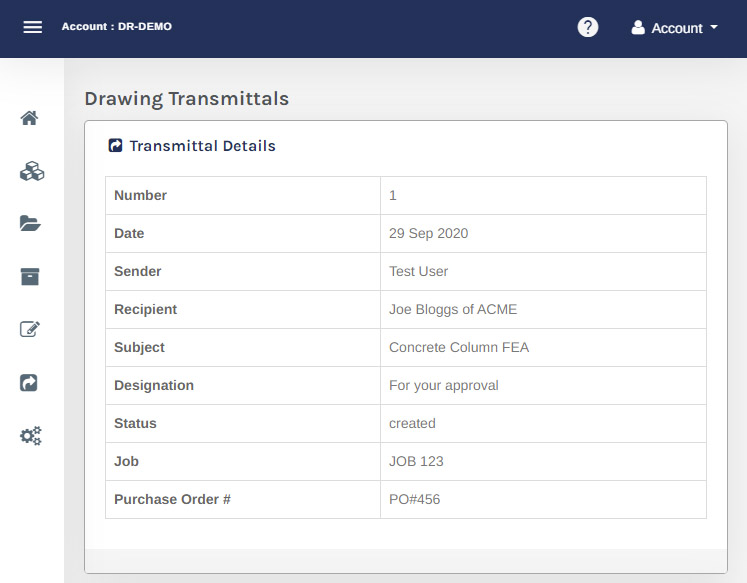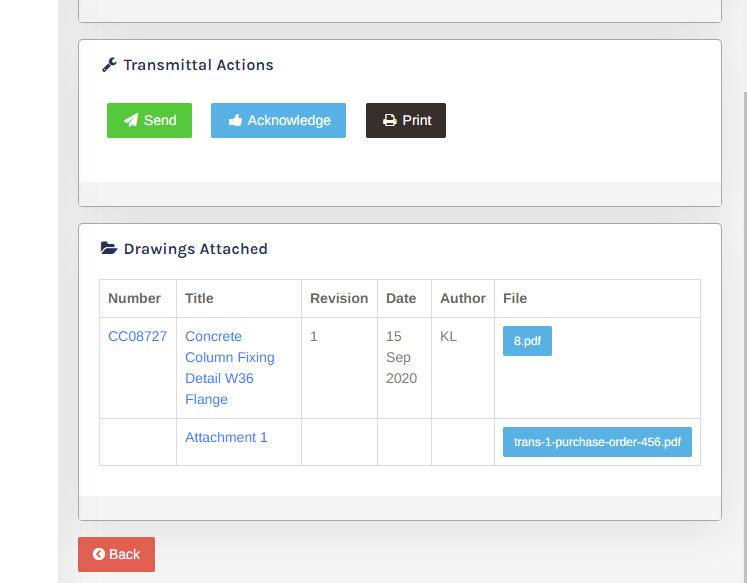Drawings transmittals are an important part of a drawing register system. But what exactly is a drawing register? and why would you use one? In this article I will explain the parts of a drawing transmittal and why they are important.

In its simplest form a drawing transmittal is a record either hard copy or electronic showing who sent which drawings to who, when and why.
A drawing transmittal is used to control the distribution of drawings to ensure the correct drawings and versions of those drawings are sent to the correct recipient for the agreed purpose. The transmittal serves as a historical record for what happened in the event there is a dispute in the future over an inconsistency.
The Sender & Recipient
The sender or originator of the drawing transmittal is the person who has possession the drawings and wishes to send or distribute them for a particular purpose. They may be issuing fabrication drawings to a sub-contractor, or issuing the latest version of construction drawings to a builder, or sending drawing changes to a customer for their approval. Whatever the reason the drawings are being sent, they should not be distributed from a drawing control system without a transmittal.
The recipient or recipients will be the person or company who needs the drawings for a particular purpose. They may be a supplier who is pricing something for procurement purposes, a builder who is receiving the most up to date version of project construction drawings or anyone else who needs to review, fabricate, approve, use or have the drawing for some purpose. There are often many recipients on the one transmittal.

The Reason for the Transmittal
It is important to include the actual reason the drawings are being sent. It is not enough to just simply have the sender, recipient and the drawings on the transmittal. Think about the scenario where some drawings are sent to a fabrication shop for pricing. The recipient must simply review the drawings and provide a price in response. Perhaps some time passes and months later another transmittal is sent for the fabricator to actually construct and fabricate the parts on the drawings. It is very important that the fabricator knows the purpose as different version of drawings may include different information as the parts move through the design process. Tolerances, material specifications and dimensions can change between the quoting and fabrication phase of a project. Therefore it is important to send separate transmittals for each purpose and clearly state it.
What Information Should Be Included
When sending drawings there are several things you need to include at the very least to identify which drawings were included in the transmittal, in the event you do not physically keep a copy of the actual drawings along with the transmittal record.
These are the minimum parameters that should be listed on the transmittal;
- Drawing Number
- Drawing Title
- Drawing Version
- Drawing Date
- Drawing Author

This information is critical, especially the version. It is a common occurrence where parts are fabricated or constructed and they have used an old version of the drawing because they either didn’t get a copy of the latest drawing with the instruction or they assumed it was the same and went to an existing copy they already had, to do the work. This creates needless waste and can end in time and cost increases and disputes.
Sending & Acknowledging
Transmittals should be sent either physically as a package with the drawings attached behind the cover sheet with all the critical information, or electronically with the drawing files attached electronically to the transmittal record.
Once sent, it is not enough to assume that the recipient received and understood the reason for the transmittal. You must close the circle of responsibility and the recipient should acknowledge the transmittal. This is often accomplished by sending back a copy of the cover sheet with their signature on it. Or it can be achieved by replying to a electronic transmittal sent via email, for example.
If your transmittal system follows the framework outlined in this article you are in good hands. If it does not, you should make some changes now.